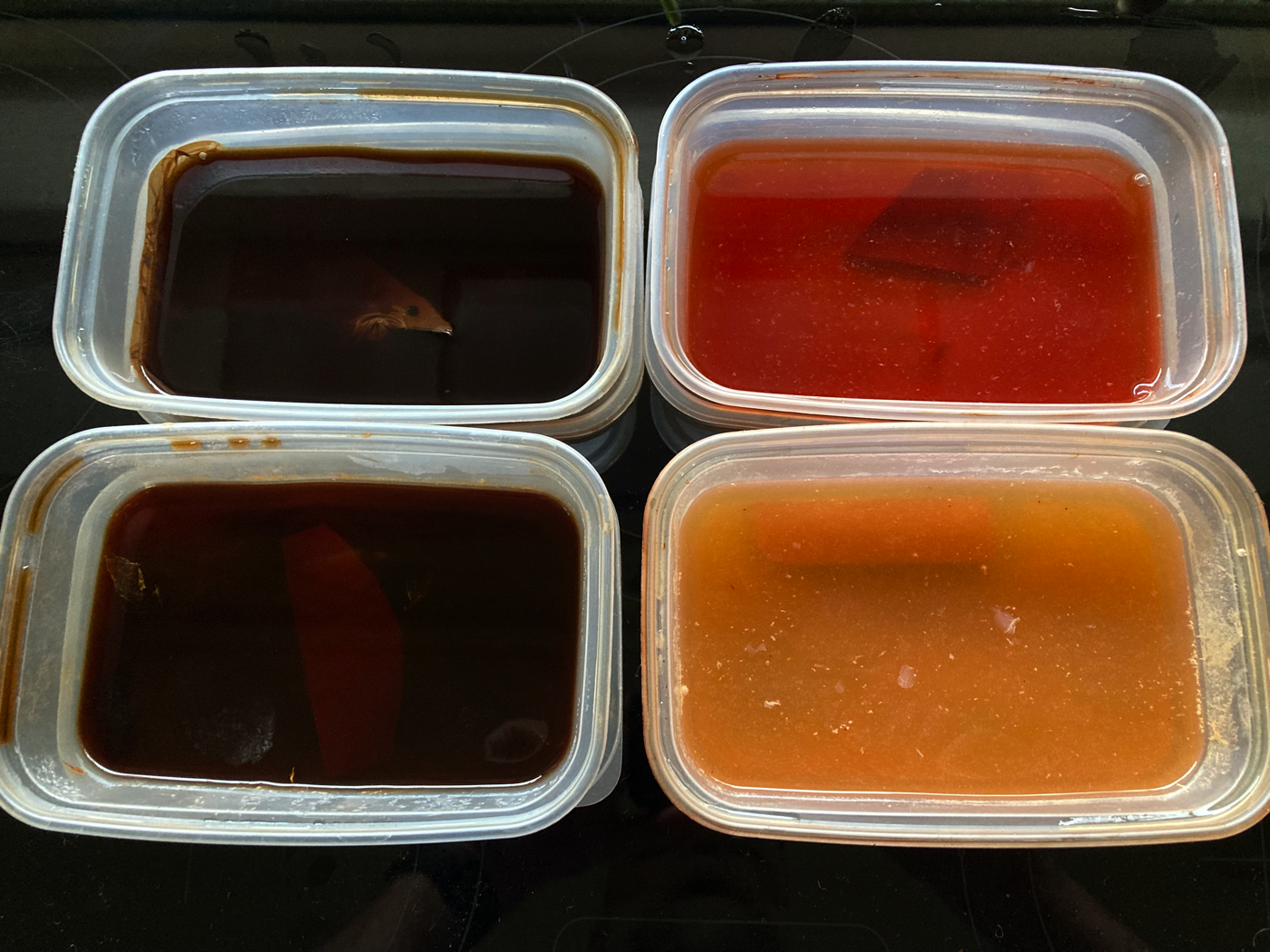Natures Resources - Natural Dyes
Natures Resources, natural dyes - Dye baths, top left Walnut, top right Elm, bottom left Hawthorn and bottom right Cherry.
Natural Dyes - Introduction
Natural dyes are a topic often overlooked in bushcraft circles. Whilst not immediately necessary for day to day survival, there is a growing body of archeological evidence that shows the use of colourful dyes well into prehistoric times. The often portrayed image of our ancestors being dressed in drab brown fabrics and animal skins is perhaps not a realistic paradigm.
Natural dying is an amazingly rich topic which ranges from being very simple and easy to achieve to a subject with a great deal of complexity, with a wide range of colour results obtainable.
My interest started by exploring natural materials to make dyes for leather, as a cheaper and more environmentally friendly alternative to the commercially available dyes.
It’s not just Leather that can be dyed. Cordage, fabric and indeed any material made from natural fibres can take on natural dye colorants.
Natural Dyes - Materials
Below is a very abbreviated list of common trees and plants that can be used to make natural dyes:
Trees
Elm (pinks, greens and yellows), Oak (brown), Walnut (brown to black) , Hawthorn (yellows, greens and greys) , Cherry ( greens and pinks)
Parts used: Leaves, Catkins, Bark
Plants
Golden Rod (yellow and red) Bramble (purples, browns and yellows) , Ladies Bedstraw (reds, greens and browns), Nettles (greens and browns), Onions (oranges)
Parts Used: Flowers, Leaves and Roots
Fungi, Lichens
Fungi and Lichens produce an amazing range of colours, far too many to list. Its worth a quick Google to see the wide variety available.
In comparison to trees and plants, fungi require slightly more processing and technology to extract the dyes.
Mordants and modifiers
Mordants and modifiers are chemicals added to the base dye that modify colour and help fix it, preventing it from washing out of the material dyed.
Common chemical mordants are copper sulphate, aluminium sulphate (Alum), ferrous sulphate.
Natural mordants include wood ash lye, rhubarb leaves and oak galls.
Mordants and modifiers can brighten or darken the base dye colour and even radically alter the final colour generated.
At this point it’s worth mentioning that caution should be taken when handling the natural materials and chemicals used. Some may be poisonous and some have the potential to cause allergic reactions in people who are susceptible.
Natural Dyes - How to make a natural dye.
Natural dyes are made from plants, trees or fungi, usually by making a tea or liquor by boiling the vegetation in water for a couple of hours until the base dye is extracted into the water.
Natures Resources, natural dyes - Bramble gathered from the hedgerow
The material is collected and broken up into small pieces. This allows the natural dye to be easily extracted.
Natures Resources, natural dyes - Hawthorn bark and leaves broken up and ready to use.
The vegetation is covered with water in a stainless or aluminium pan and brought to the boil. Cast iron pans should be avoided as the iron can react with the natural dye altering it. Its also worth considering that brewing up natural materials might not be the best use of your household pots and pans!
Natures Resources, natural dyes - Oak bark boiling to form the dye liquor.
Boiling times can vary depending on the nature of the material, how small it has been cut up etc. I have found 2 hours works well for most things but equally have had success with boiling time as short as 30 mins. Generally, the dye will become stronger the longer it is boiled for, up until the point no more dye can be extracted from that batch - this requires a bit of trial and error to figure out.
The boiled liquor is allowed to cool and is drained off of the spent vegetation. It’s worth straining the liquor through a muslin or cotton cloth to remove any sediment that may cause patchy results in your dye bath.
Natures Resources, natural dyes - Sediments removed from the dye by filtering through an old cotton tea towel.
Once cooled, the dye is ready to use immediately and can be safely stored for a couple of weeks in a fridge without issue. I have found that dye baths left more than a couple of weeks unrefrigerated can start you grow a film of mould over the surface. This may affect the quality of the dye.
Depending on the material you are dying, you may choose to use the dye hot or cold. Heating up the liquor can speed up the absorption of the colour but care must be taken to avoid cooking the material being dyed. There is a lot of guidance available both on the internet and in good quality dying books, but a good starting rule of thumb is that if the dye bath is too hot to put your hand in, it’s too hot for the material.
Natures resources, natural dyes - strained Oak dye liquor ready to use.
For leather, I chose to experiment with a cold bath without any mordants or fixers - this being the simplest route to achieving a colour. I routinely finish my leather good with a waxed based sealant which should fix the dye in place.
I experimented with four dyes made from Walnut, Elm, Hawthorn and Cherry.
Natures Resources, natural dyes - Dye baths, top left Walnut, top right Elm, bottom left Hawthorn and bottom right Cherry.
A small off cut of leather was left to soak in its dye bath of around two weeks (ok, being honest here, I forgot about them….)
Natures Resources, natural dyes - Dyed leather samples removed from the dye bath
Once dyed, the leather pieces were removed and allowed to dry naturally. With use the liquor becomes exhausted resulting in lighter and lighter shading until it is unusable.
Whilst wet, the colours that the leather samples had taken on was quite vibrant. The walnut was a dark brown tending to black, the elm had a red hue, the Hawthorn a mid brown and the cherry had a slight yellow sheen. The pictures really do not do them justice.
It is worth noting that the the colours will tend to lighten as the dyed product dries out. This should be expected and accounted for when choosing the natural dye you wish to use.
Natural Dyes - The result
The final result compared to a natural coloured piece of veg tanned leather. The Walnut sample has dried a rich dark brown, the Elm has a dark red brown hue and the Hawthorn is a mid brown a shade or two darker than saddle tan.
Natures Resources, natural dyes - the dried dyed samples - try saying that fast!
Disappointingly the Cherry sample has dried virtually the same colour as the natural colour - just a shade darker with no sign of the yellow previously seen.
For me this experiment with natural dyes was a great success. I will definitely be using the walnut dye moving forward. I think it would look fantastic on a knife sheath.
What natural dye would you make and what would you use it on?









